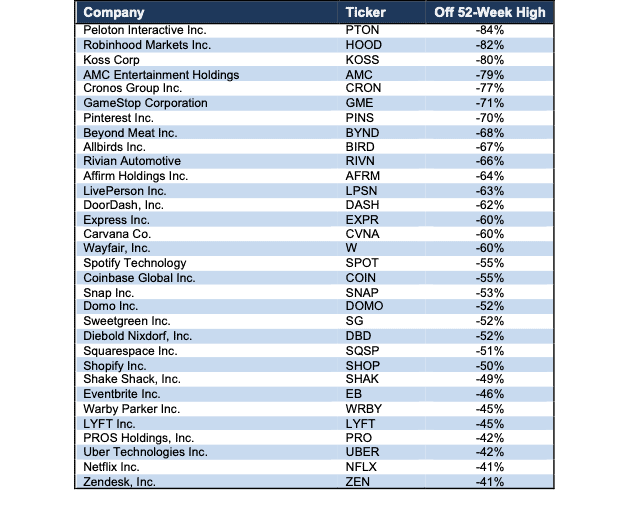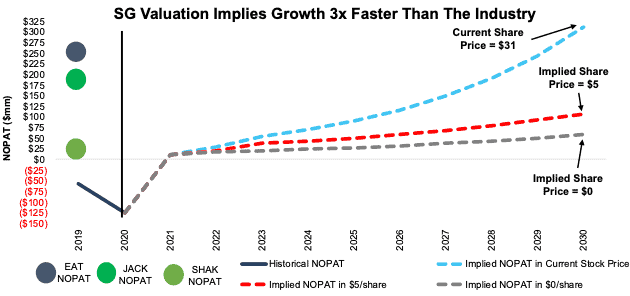We published an update on SG on March 13, 2023. A copy of the associated report is here.
We counsel investors not to try and catch falling knives – stocks that have seen steep declines but still have further to fall. As the market rotates away from high-flying growth names to more stable cash generators, investors need reliable fundamental research, more than ever, to protect their portfolios from falling knives.
We continue to post an exceptional hit rate on spotting overvalued stocks. Currently, 62 out of our 65 Danger Zone stock picks are down from their 52-week highs by more than the S&P 500. Figure 1 lists the open Danger Zone picks that are down at least 40% from their 52-week highs. Our Focus List Stocks: Short Model Portfolio, the best-of-the-best of our Danger Zone picks, outperformed the S&P 500 as a short portfolio by 36% in 2021 with 29 out of our 31 picks outperforming the index.
This report highlights one particularly dangerous falling knife: Sweetgreen (SG: $31/share). We highlight four other falling knives in other reports published today: Allbirds (BIRD: $12/share) here, Carvana (CVNA: $150/share) here, Wayfair (W: $140/share) here, and Shake Shack (SHAK: $64/share) here. Each of these stocks have dropped at least 40% from all-time highs, yet still carry at least 40% additional downside risk.
Figure 1: Danger Zone Picks Down >40% From 52-Week High – Performance through 2/4/22
Sources: New Constructs, LLC
Falling Knife: Sweetgreen (SG): Down 53% from 52-Wk High & 100% Downside Remaining
We put Sweetgreen in the Danger Zone in in November 2021 prior to its IPO. Since the opening price on IPO date, the stock is down 49% while the S&P 500 is down just 5%. The pain is not over for Sweetgreen’s shareholders as the stock could fall to $0. We detail why Sweetgreen’s undifferentiated business, industry-worst profitability, and competitive challenges could lead to $0/share in our report here.
Sweetgreen Is Priced to Grow Faster than Chipotle Did
When we use our reverse discounted cash flow (DCF) model to analyze the future cash flow expectations baked into Sweetgreen’s current valuation, we can provide clear, mathematical evidence that $31/share appears too high and offers unattractive risk/reward.
To justify its current price of $31/share, Sweetgreen must:
- improve its NOPAT margin to 4% (vs. -57% in 2020) in 2021, 8% in 2022, and 12% (Chipotle’s best-ever margin) from 2023-2030, and
- grow revenue by 28% (vs. -20% in 2020) compounded annually for the next ten years (over 3x the expected industry growth rate through 2025).
In this scenario, Sweetgreen would generate $2.6 billion in revenue in 2030, which is nearly 12x its 2020 revenue. In this scenario, Sweetgreen’s 28% revenue CAGR is higher than the 22% revenue CAGR Chipotle achieved in its first 10 years after going public.
In this scenario, Sweetgreen also generates $313 million in NOPAT in 2030, which implies a total increase of $439 million, given its 2020 NOPAT is -$126 million. For reference, once going public, it took Chipotle nine years to increase NOPAT by $440 million. However, Chipotle was offering a differentiated product and, more importantly, was already profitable.
In other words, Sweetgreen must grow revenue faster, and improve profits on par with Chipotle in its first decade as a public company, or the stock is worth much less than its current valuation.
83% Downside Even if Growth Exceeds 2x Fast Casual Projections
A second DCF scenario highlights the downside risk should Sweetgreen’s revenue grow by “only” 2x projected industry growth.
If we assume Sweetgreen’s:
- NOPAT margin rises to 4% in 2021, 7% in 2022, and 11% (equal to Chipotle’s TTM margin) from 2023-2030, and
- revenue grows by 16% (2x the projected industry growth CAGR from 2021-2025) compounded annually from 2021-2030, then
Sweetgreen is worth just $5/share today – an 83% downside to the current price.
Should Sweetgreen struggle to improve margins at such a rapid pace or grow revenue more in line with the overall industry, the stock could be worth nothing.
100% Downside if Sweetgreen Matches Shake Shack’s Margins
We review an additional DCF scenario to highlight the downside risk should Sweetgreen’s margins match Shake Shack instead of Chipotle.
If we assume Sweetgreen’s:
- NOPAT margin rises to 4% in 2021 and 6% (equal to Shake Shack’s average margin since its IPO) from 2022-2030, and
- revenue grows by 16% compounded annually from 2021-2030, then
the stock is worth $0. See the math behind this reverse DCF scenario.
In this scenario, Sweetgreen’s NOPAT in 2030 is $58 million. After accounting for total debt, preferred stock, and outstanding employee stock options that decrease shareholder value by $1.0 billion, there is no remaining value for shareholders.
Figure 2 compares Sweetgreen’s implied future NOPAT in these three scenarios to its historical NOPAT. We also include the 2019 (pre-pandemic) NOPAT for restaurant peers Jack in the Box (JACK), Brinker (EAT), and Shake Shack (SHAK) for reference.
Figure 2: Sweetgreen’s Historical and Implied NOPAT: DCF Valuation Scenarios
Sources: New Constructs, LLC and company filings
Each of the above scenarios also assumes Sweetgreen grows revenue, NOPAT, and FCF without increasing working capital or fixed assets. This assumption is conservative given the company plans to double its store count over the next three to five years. For reference, fast-growing, fast-casual restaurant Shake Shack grew invested capital 22% compounded annually from 2012 to 2020. Should Sweetgreen’s invested capital grow at an even faster rate than assumed in the scenarios above, the stock has even more downside risk.
Fundamental Research Provides Clarity in Frothy Markets
2022 has quickly shown investors that fundamentals matter and stocks don’t only go up. With a better grasp on fundamentals, investors have a better sense of what and when to buy and sell – and – know how much risk they take when they own a stock at certain levels. Without reliable fundamental research, investors have no reliable way of knowing whether a stock is expensive or cheap.
As shown above, disciplined, reliable fundamental research shows that even after plummeting, Allbirds, Sweetgreen, Carvana, Wayfair, and Shake Shack still hold significant downside.
This article originally published on February 7, 2022.
Disclosure: David Trainer, Kyle Guske II, and Matt Shuler receive no compensation to write about any specific stock, style, or theme.
Follow us on Twitter, Facebook, LinkedIn, and StockTwits for real-time alerts on all our research.


